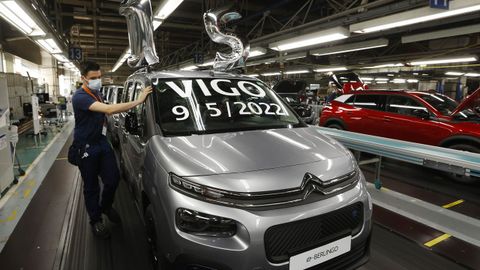
Author: stellantis
It is recovering the fourth shift, which will be joined by new employees
Stellantis Vigo will operate at maximum capacity from mid-September. It will do so by putting into operation, i.e. by restoring, — it stopped working in October 2021 — the fourth work shift, which will cover the factory’s activities on Saturdays and Sundays, and for which, as announced yesterday, the factory’s management to the works council, 700 jobs will need to be filled with new employment.
Currently, Stellantis Vigo’s workforce consists of 5,700 employees, which is a relatively low figure compared to the 7,000 reached at the peak of production a few years ago; and far from the 10,000 that were added in the years 2008 and 2009, —when the factory broke the production record (530,000 units per year)—, figures that will not be repeated, due to the progressive robotization of the assembly process and, above all, to the higher production volume of 100% electric vehicles that require less assembly line work.
The workers currently on the payroll are on indefinite leave, practically all of them, as the crisis in the supply of electronic components that the automotive sector is suffering globally has forced the management of the Galician factory to activate three consecutive documents on temporary employment (ERTE) —the third will remain in force until the end of this year, even if activity forecasts improve, to cover possible problems with suppliers—, to mitigate activity interruptions; and lay off most of the temporary workers.
the best second semester
With the announced programming, after improving the forecasts that Stellantis leads, at least for the second half of the year, the workforce will increase to around 6,500 workers.
For months, Vigo’s management tried to activate this fourth shift, which is in charge of working on Saturdays and Sundays, but geopolitical instability did not allow it. Now, as the management explained to the union representatives, stability is expected in the course of the supply chain, especially electronic parts whose delivery failed due to the global microchip crisis. To this improvement of the factory’s supply network was added, in addition, production growth forecastsarose from the increase in demand for models leaving the factory in Galicia, especially the range of light commercial vehicles produced by Stellantis in Vigo, on the same production line, under the brands Peugeot, Citroën, Opel, Toyota and Fiat, with a volume of around 250,000 units per year, of which 90% is sold on the foreign market.
The Galician factory now produces only the electric version of the commercial offering for private customers, while limiting the production of vans with internal combustion engines for professionals and companies.
The management of Stellantis Vigo plans to soon open the process of selecting new incorporations, all temporary, for their training and immediate establishment in the second half of September.
From that date, the factory in Galicia will operate in four shifts without interruption: morning, afternoon, night and weekend, with an activity rate of 2,800 cars produced per day, which is equivalent to almost two units per minute.
Source: La Vozde Galicia
I am Jason Root, author with 24 Instant News. I specialize in the Economy section, and have been writing for this sector for the past three years. My work focuses on the latest economic developments around the world and how these developments impact businesses and people’s lives. I also write about current trends in economics, business strategies and investments.







